A Guide To Concrete Floors
Concrete floors have a raw and elegant beauty that can be surprisingly warm
The days of concrete floors being banished to the basement or sub-floor of a house are long gone. Today these floors offer a contemporary aesthetic that not only looks good but can contribute to the warmth of a house through thermal mass. Concrete is also durable, easy to care for and available in a range of textures, polishes and colours. This guide gives you the lowdown on concrete flooring.
What to consider when choosing concrete flooring
- For a new build, concrete is poured early on in construction so aggregate mix, colour, finishes and underfloor heating may need to be decided at this stage.
- When it comes to stripping back a floor to reveal the concrete slab, keep in mind the original pour was not intended to be exposed. So while it will function as a flooring surface after the necessary treatment, it may have an inconsistent look – for example, areas of little to no aggregate next to areas with a lot of aggregate.
- The level of polish will affect the overall aesthetic of the floor as well as the budget. A light polish or matte look is less expensive, gives a more natural look and doesn’t show many of the stones inside the substrate. In comparison, a heavy polish is more expensive and will expose the stones and provide a more colourful finish.
- Other finishes can include stamping, dyeing, embossing, staining and more.
Find a top-rated architect from the Houzz directory to design your home
The pros of concrete flooring
- Concrete floors can be a cost-efficient option, but the finishes, treatments and installation will influence the final cost.
- An endless variety of colour and texture effects is possible. Colour can be mixed directly into the concrete before the pour, or existing floors can be stained, dyed or painted.
- Concrete is extremely tough and durable. While it is possible to chip or scratch a concrete surface, it is difficult to do so. Plus, it’s flood and fire-resistant and will last a lifetime and beyond when polished and maintained.
- Concrete floors can work as a thermal mass when exposed to the sun, making a big difference in comfort and utility bills. It will absorb and store the heat of direct sunlight and slowly release it over the rest of the day and into the night.
The cons of concrete flooring
- Concrete floors can look and feel cold without sun exposure, but a great rug can always help warm them up.
- Concrete floors can injure people and damage objects if they hit the surface hard, so they’re not recommended for areas frequented by children or elderly people.
- Concrete is susceptible to penetration by moisture if not properly sealed on both top and bottom surfaces, which can lead to the growth of mould or mildew.
- Because concrete floors have no give, they can be hard on joints and other body parts – backs and feet especially. Rubber mats or cork cushioning in areas such as the kitchen, where lots of time is spent standing, can help reduce this, as can slippers or soft-soled shoes.
- A lot of energy is used in the production of concrete flooring. However, this is offset by its ability to reduce future energy usage by acting as a thermal mass.
Maintaining concrete flooring
- Concrete floors are easy to look after – just sweep and mop with soapy water or a neutral cleaner.
- Seal or wax the floors regularly in high-traffic areas to maintain the protective layer over its surface.
- Re-polish floors as needed to maintain the desired gloss.
Variety of concrete floors
Polished concrete flooring is measured by grade and finish – the higher the grade, the larger the exposed aggregates, and the higher the finish, the shinier the polish. This structural concrete slab has selected aggregates and a natural oxide colour. It has been left exposed and polished to a level that makes the aggregates clearly visible.
Wondering which type of stones are ideal for Indian floors?
Polished concrete flooring is measured by grade and finish – the higher the grade, the larger the exposed aggregates, and the higher the finish, the shinier the polish. This structural concrete slab has selected aggregates and a natural oxide colour. It has been left exposed and polished to a level that makes the aggregates clearly visible.
Wondering which type of stones are ideal for Indian floors?
Polished concrete flooring is ideal for high-traffic areas, such as hallways and kitchens. The shine on this floor is achieved by using a high-gloss polyurethane finish on top of the concrete slab.
The wide range of aggregates and colours available can easily change the look and feel of a room. This living space has white polished concrete floors that, matched with white walls and furniture, give a crisp, cool and glamorous look.
In comparison, these polished concrete floors have a great sense of warmth, due to the colour added. It has a rich brown tone that works beautifully with the wooden beams and other decorative details. Colour can be added to the pour in the initial stages and can also be added later as water-based dyes or acids.
Another way to add warmth is to lay down a rug. It also helps to define spaces or the functions of different areas in a large open space. Of the concrete in this house, designer Jasmine McClelland says, “The balance of textures and colours in the aggregate of the polished concrete flooring were chosen deliberately to soften the effect of the concrete.”
Burnishing is a type of finish that is applied to a new concrete pour before it is cured. A power trowel, or helicopter, is used to create a finish with a level of sheen, and the inconsistencies in colour are intended to be part of its appeal.
As concrete is suitable for both interior and exterior spaces, it can be used to create an indoor-outdoor look. This floor is natural concrete with no additive and a fine aggregate. “It is almost burnished by the helicopter finish after it has been poured and while it is still wet,” says Shelley Indyk of Indyk Architects.
Holes and wear and tear on existing or covered-up concrete slabs can contribute to the final look of a room. This floor had been covered with tiles, and once they were pulled off and the grinding finished, the floor was pitted with holes. An amber-coloured resin product was used to fill those holes before polishing. It adds a real point of interest to the finished floor.
Aged concrete floors or previously covered concrete slabs may have cracks. These can be hidden under a rug or taken advantage of as part of the aesthetic.
Read more:
10 Unique Options for Your Floors
Tell us:
Do you have concrete flooring? Why did you choose this material? Share your photos and reasons in the Comments below.
Read more:
10 Unique Options for Your Floors
Tell us:
Do you have concrete flooring? Why did you choose this material? Share your photos and reasons in the Comments below.





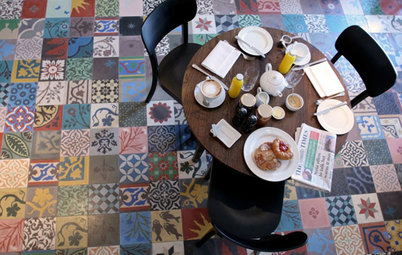
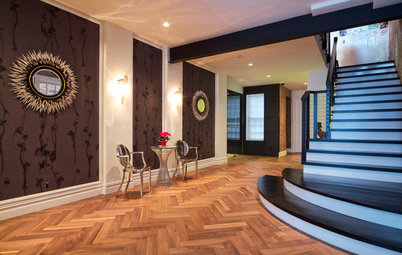
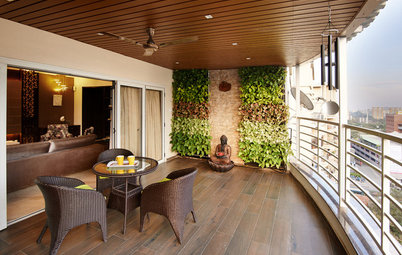
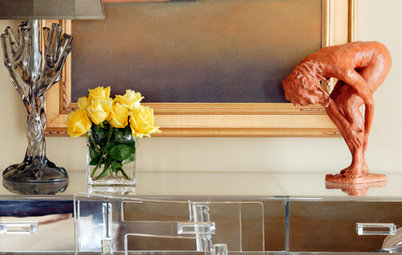
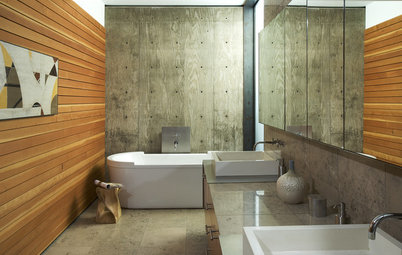
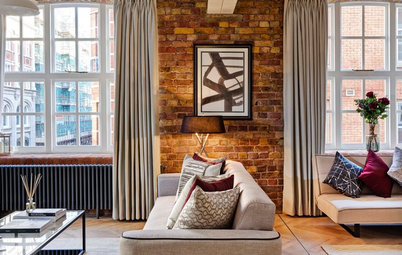
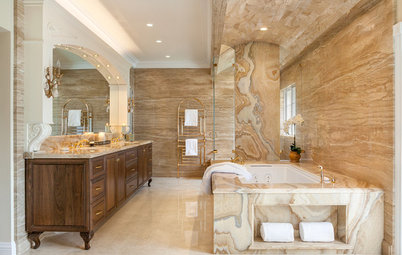
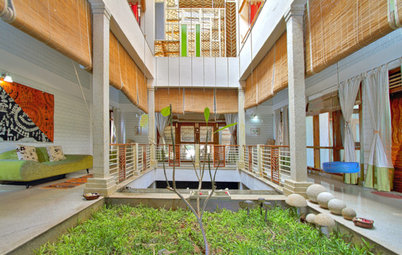
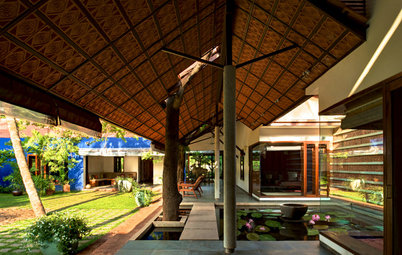
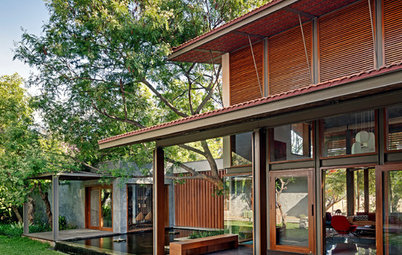
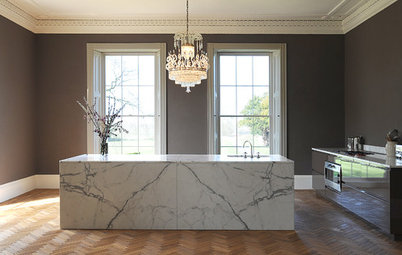
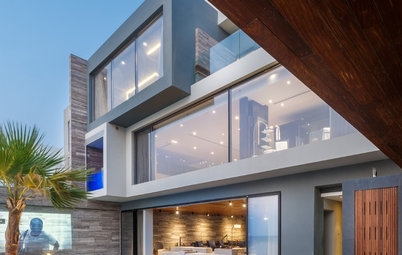
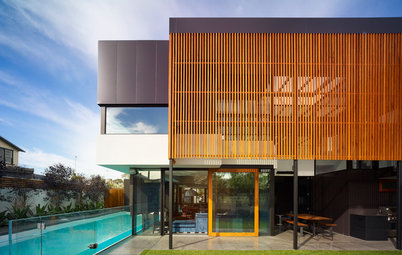
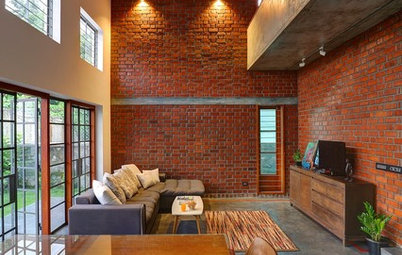
Concrete is a natural composite material made from an aggregate (rocks, river stones and granite chips) combined with a cement binder (such as limestone and calcium sulfate) and water. It is the most basic flooring material and generally forms the subfloor or base of a building that may be covered with wood or tile, or left exposed.
Concrete floors can be poured as part of a new build, or an existing floor can be stripped back to its concrete slab as part of a renovation. A series of treatments can then transform the slab into a smooth and decorative surface appropriate for flooring.
Browse through images of concrete flooring